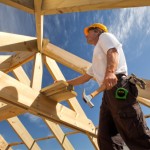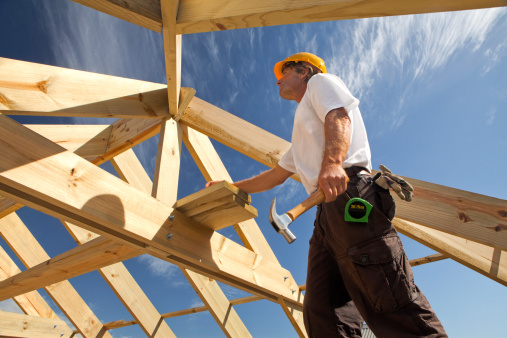More and more people are taking the self-build option when it comes to creating their ideal home but how do you go about it?
Rebekah Commane finds out the basics
Many people dream of building their own home from scratch or converting a building with historical significance into an original dwelling, the likes of which are seen on the ever-popular TV show, Grand Designs. But whether you aspire to create a lavish masterpiece or a simple two-up two-down, it can be difficult to know where to start and there are many elements to consider.
 The first thing to establish when considering a self-build project is which type of development you are aiming for. Paul Broadhead, head of mortgage policy at the Building Society Association, explains that there are three main types of self-build to consider. They are:
The first thing to establish when considering a self-build project is which type of development you are aiming for. Paul Broadhead, head of mortgage policy at the Building Society Association, explains that there are three main types of self-build to consider. They are:
Self-built one-off home
This is the most labour intensive type of self build project. You will be responsible for locating a plot, managing the design and construction process and it is likely that you will also undertake a fair proportion of the actual building work too.
Contractor built one-off home
If using a contractor, once you have located the plot of land you will manage the design process, select a contractor and then they will take care of the construction work.
Developer built one-off home
The most straightforward of self build projects where you find a developer with a site and a design you like – they then take care of almost everything.
Legalities
Next, the legalities involved in a self-build project should be considered. Jon Hall, CEO of Saffron Building Society, told What Mortgage that there are several factors to think about from a legal point-of-view when looking into self-builds. These include planning permission and building regulations approval.
“Also, when considering demolishing or altering a listed building there are extra legalities to consider as listed building consent will be required, while restrictions on the type of build will apply in some areas,” added Hall.
Broadhead explained that borrowers should have submitted working drawings for Building Regulation design approval with either the local authority or an approved inspector.
“Titles should be checked by the conveyancer as would be the case for a traditional purchase. Special attention should be paid to rights of way and any other restrictive covenants with adequate cover being in place.
“Contracts should be utilised by the borrower for the engagement of professionals, along with main suppliers of materials and each builder or trade contractor.”
Giving details of the many elements to consider with self-build projects, Broadhead said that low cost, purpose written contracts are available from Self-Build Zone and ContractStore or a legal firm. Each contract will detail a description of the project, labour costs, payment systems, a specification of the materials to be used, their costs and who will source them. The borrowers should have arranged for the property to be built under a recognised warranty scheme, which provides insurance for the housing unit for ten years post-cover against defects in the design, materials and workmanship.
Warranty
The warranty provider will check that the design and workmanship is acceptable throughout the construction process, through a series of site inspections or technical audit checks (this can incorporate the Building Control functionality if it’s been arranged via the warranty provider).
There are a number of warranty providers in the market but four of the main providers are NHBC, Build-Zone, LABC and Premier Guarantee.
Self-builders will require a variety of insurance policies, depending on the method of acquiring their build. They should have site insurance, which normally covers loss or damage to the building works, temporary works and materials for incorporation therein (and existing structures in respect of conversion projects); public liability; employer’s liability, together with personal accident; JCT (Joint Contracts Tribunal) clause 21.2.1 insurance, to cover possible damage to the surrounding area.
As well as finding appropriate land, securing planning permission and the numerous other legalities, self-build borrowers should be prepared to have a larger deposit than on a traditional mortgage; up to 40 per cent of the cost is not unusual.
Affordability
Hall explained that the amount of the mortgage to be advanced is determined by a percentage of the cost or the value of the original land plus an additional amount determined by the amount of build work involved. All of this is considered against the end value of the project at completion.
Meanwhile, Broadhead explained that it is possible to obtain a self-build mortgage with as little as a 10 per cent deposit.
“It is also a good idea to have a contingency fund of 10 to 15 per cent of the build cost as unexpected costs can sometimes crop up and increase the budget required for a project,” he added.
The need for a ‘safety net’ of savings to allow for unforeseen costs is also highlighted by Kevin McCloud, in his interview with What Mortgage on page 20 to 21.
If a plot of land is inherited the value of the land cannot generally be used as security against a mortgage as there is the potential for the value of the land to drop once building work has commenced. But it will significantly increase the amount of equity in the property once it is completed if the consumer is not financing land as well as build costs.
If the borrower is looking to lend a sum to cover the cost of the land purchase, as well as the build, most self-build providers will provide this finance, although a larger deposit is generally required on the land than on the property itself.
For those with an existing mortgage but looking to take out a loan for a self-build project it is more difficult to secure finance. As self-build mortgages are paid in stages, lenders will need to ensure that the borrower can afford the payments on the second mortgage as well as the first.
Broadhead recommends speaking to a variety of lenders as there are a number of self-build products available and what can be offered depends on the individual case.
“Many building societies will look at projects on a case-by-case basis so it’s a good idea for people to shop around. That said, self-build is more specialised than funding a traditional property purchase so there are not as many products available as in the rest of the market.”
Currently 24 building societies and an array of banks provide mortgages for self-build, so there is plenty of choice. wm



